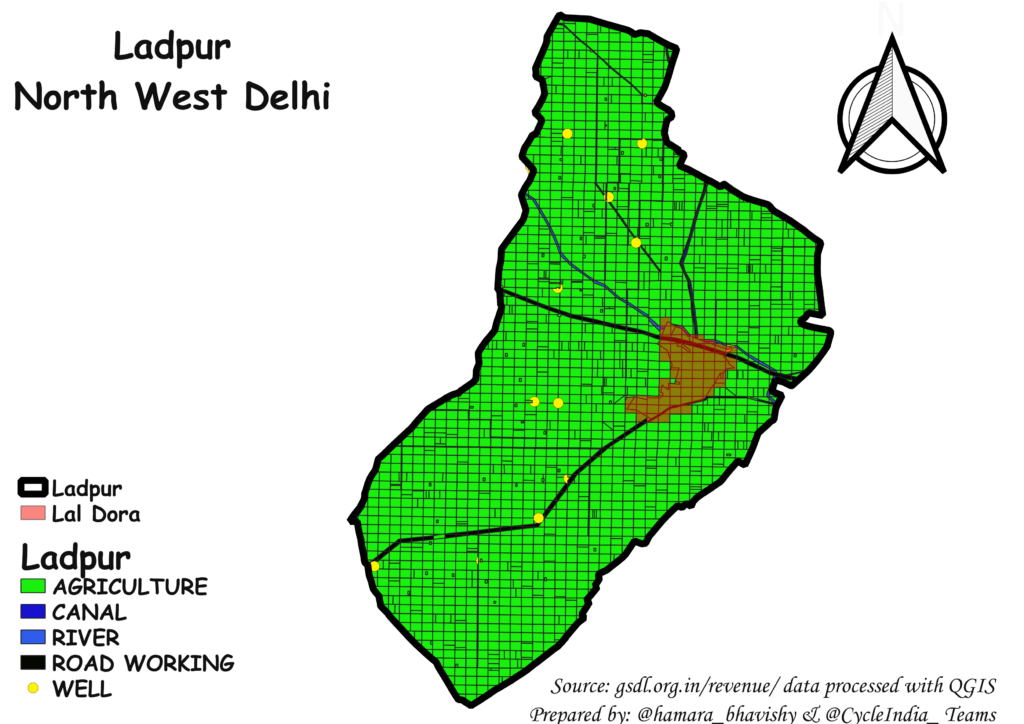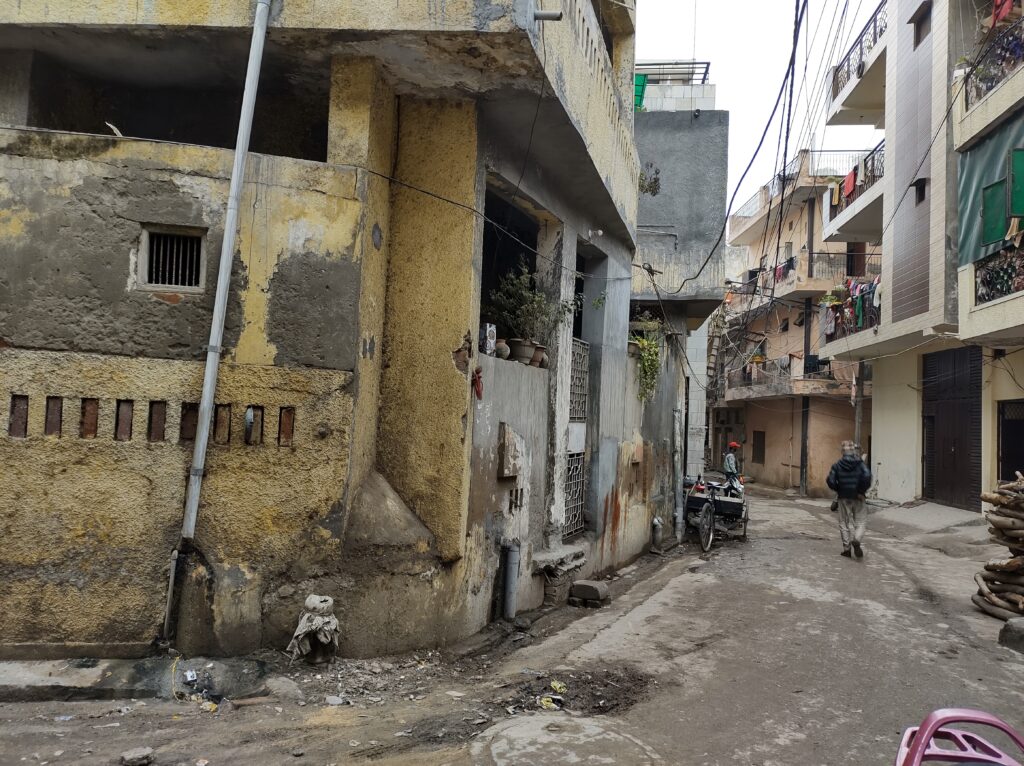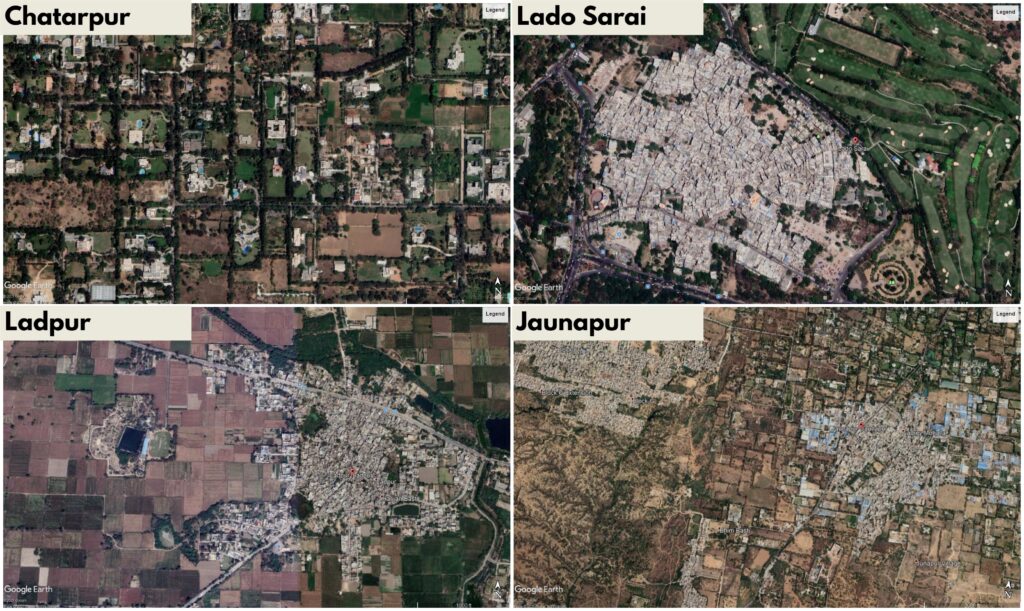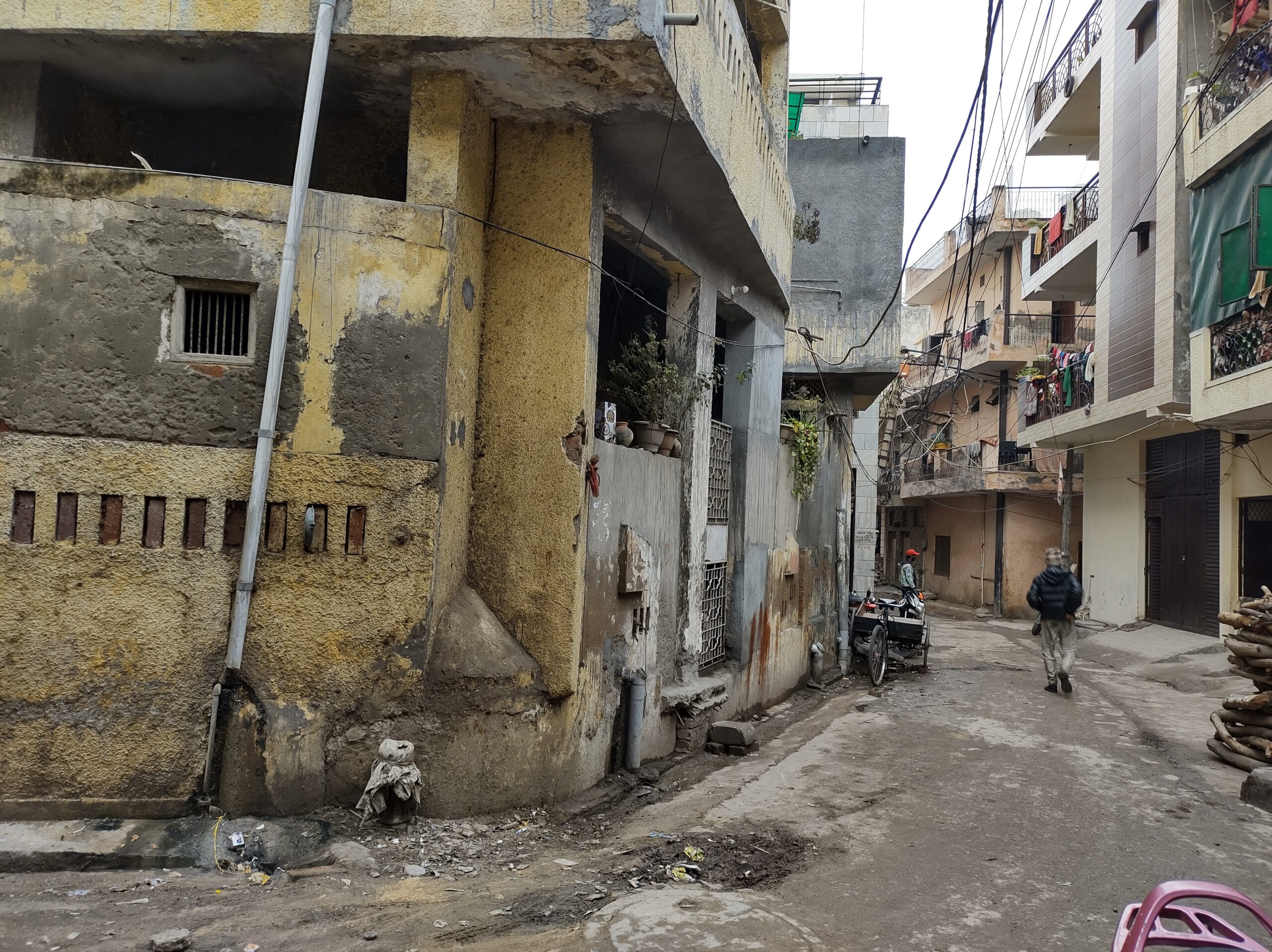This is the first article of a two-part series on the disappearing commons and evictions in Delhi’s lal dora villages. To read part two, click here.
Northwest Delhi’s Ladpur looks as oxymoronic as its designated status of an ‘urban village’. Its periphery is marked by a vast, open patch-work of brown and green fields. But its residential area, agglomerated at the core of this expanse of fields, is cramped and congested, with narrow roads leaving just a little space between the homes where over 5,500 people reside. “We live in pigeon holes,” says Rajesh Dabas [45], a teacher and resident of Ladpur.
Ladpur is one of Delhi’s many lal dora villages—a colonial term derived from the red markings on maps of Delhi that were used to separate residential areas from agricultural land. More than 130 such lal dora villages were officially ‘urbanised’ by 2017, and 168 more by 2020, bringing them within the urban limits of the city. Ladpur too was declared an urban village in 2017. But, its concentrated and cramped housing reflects an ugly truth—the village, like most other lal dora villages in Delhi, was not allowed to expand its boundaries further, neither as its own population multiplied, nor as the rest of the city grew around it.

Dabas and his neighbours should not have had to live in such cramped residences. The East Punjab Holding (Consolidation and Prevention of Fragmentation) Act of 1948 was extended to Delhi in 1963. Apart from the compulsory consolidation of fragmented agricultural holdings, the Act also provides for the extension of the ‘abadi’, which is the ‘living area’ of villages. Once extended, the land can be used by the villagers for residential and common purposes.
Since 1952, such extension orders were issued from time to time for Delhi’s lal dora villages, but were often plagued by delays. During these delays, residents hastily concretized whatever little land was available to provide for their growing families.
“What can people do? When no arrangements were made for our village’s expansion, where would they build houses? We are not allowed to do so on agricultural land. The only other option once the limited land is used up is to expand into the land of the Gram Sabha [commons of the village].” Today, about 130 bighas (approximately 32 acres) of Gram Sabha land in Ladpur have homes built on them—with all such residents now termed as “encroachers” by the Delhi government and Delhi Development Authority (DDA), a body under the Centre.
But, Ladpur is not alone. The Bastion’s investigation reveals that since 1988, the land consolidation notifications for 104 villages in Delhi were issued, yet none were ever acted upon. Of these, today, at least 40 villages have been documented as having ‘encroachments’ on Gram Sabha land, forests, or around ponds. Some residents amongst these have also faced evictions by the Delhi’s Revenue Department in the past. The residential futures of many Delhiites, thus, rests on shaky ground.
Dabas believes that for such encroachers, a solution exists—the implementation of not only the East Punjab Act which extends the permitted residential areas, but more importantly, the Delhi Holdings (Consolidation and Prevention of Fragmentation) Rules, 1959. Through a 1992 amendment, these rules allow residents to exchange their agricultural land for residential land in the extended abadi. This would regularise the residences of ‘encroachers’. But, Delhi’s Revenue Office has other plans.
Land Consolidation for Residential Security
Although consolidation notifications for various rural and urban villages in Delhi were issued by the government over the decades, as of 2007, the process was completed in only ten villages. “One such village is Raota in Najafgarh, where the consolidation process was completed. There, people have their older, smaller houses as well as enough space for new plots to fulfil their residential requirements,” shares Paras Tyagi, a public policy practitioner and co-founder of the NGO CYCLE.
But an unprecedented move in 2015 by the Office of the Secretary (Revenue) and Divisional Commissioner brought the consolidation hopes of these 104 villages to a stop. A notification revoked all consolidation notifications issued for the villages stating that “it is expedient in public interest not to take up the consolidation proceedings,” with no further justification.
As far as Google Earth shows, of these 104 villages, at least 14 share similarities with Ladpur—they are all densely built lal dora villages that still hold agricultural land along their peripheries. It is specifically such villages that would benefit from consolidation and abadi extension today, given that they have agricultural land readily available to be exchanged.
Delhi Holdings Rules allows for the exchange of land in a 2:1 ratio, where a person can give up 2 units of their agricultural land for 1 unit of land to be provided in the extended abadi area. Some specifications accompany these Rules—the exchange is available only for the “bonafide residents of the village,” or those who have resided there for the last twenty years. “In our village, people have built houses on their own agricultural land. Almost 18 to 20 acres of agricultural land is thus occupied by housing,” shares Rohtas Yadav from Pandwala Khurd village, which is close to Najafgarh in southwest Delhi. “This is why our village demands that the consolidation process takes place since most people have the agricultural land required to exchange for a legal plot.”
For the other remaining villages of the 104, had the process begun when first notified back in 1988, perhaps the residential situation for them too would have been different.

To make the consolidation a reality, Pandwala Khurd and Ladpur went as far as taking the matter to the Delhi High Court. A judgment was ruled in their favour in 2011, where the Court ordered that for Ladpur, the consolidation process has not “properly commenced (..) and is affecting petitioner’s right to extension of Lal Dora.” It then issued directions to the administration to “expeditiously carry out the consolidation of village Ladpur [sic].”
“One of the biggest lacunae of the 1948 Consolidation Act is that there is no time limit stated for the consolidation to be completed within, which is why we are still left hanging after 25 years of the first notification being issued for our village,” shares Dabas. “While the court order is good progress, unfortunately, it also only uses the term ‘expeditiously’ leaving the time period open to interpretation.”
A government official who requested anonymity explains why the land consolidation process can be time consuming. “The land consolidation process for regularising residences through this 2:1 exchange requires a change of ownership as well as in land use,” they say. “For ownership, a process of mutation is needed, the work of which is led by the Sub Divisional Magistrate’s office. It takes a long time to complete. Now, converting the land use needs a separate set of permissions from the DDA, for these changes have to be in line with the DDA’s Master Plan, which marks out which areas can be used for what purposes. This permission process is also a long-drawn one.”
Nevertheless, Dabas and other residents of Ladpur see another benefit of the Delhi High Court’s favourable order. “We believe that after this 2011 court order, Ladpur and Pandwala Khurd did not appear in the 2015 list of villages whose consolidation notifications were revoked. Our notifications still stand strong,” he claims.
But in 2017, the plot thickened. Some residents of Ladpur made a representation to the Consolidation Officer of the village to stop the consolidation, putting the residential futures of all of Delhi’s urban villages in a state of flux. They too took the matter to court, and the case is currently sub-judice. The representation initiated a round of questions: are urban villages eligible to be considered under the Punjab Consolidation Act and Delhi’s Consolidation Rules, both of which primarily prevent agricultural fragmentation? Aren’t the two Acts only applicable to rural areas?
Seeking answers, Tyagi’s CYCLE filed Right to Information (RTI) applications to access correspondence between the Revenue and Law Departments. Spanning over one and a half years, this back-and forth is nothing short of a thriller.
The Urban Mess of Consolidation
The 2017 representation by some of Ladpur’s residents suggested that the village’s agricultural land had already been consolidated back in 1952. So, the demand for consolidating further residential land does not make much sense since the “villagers have already coped up with their need of housing (..) and [there is] no further significant increment of population here.”
“This demand came mainly from the large landowners of the village who owned upto 20 acres in their name,” shares Dabas. “Under consolidation, a process called muzarai takes place, in case villages do not have sufficient common lands. This is a compulsory deduction of some part of the consolidated land for the common purposes of the village [usually two biswas per bigha, or roughly 690 square feet for every 0.2 acres land]. Such big landowners do not want to lose even that much land for the [benefit of] society.”
According to the RTIs filed, the Secretary of the Revenue Department was unsure of how to proceed and requested for legal experts to shed light on the claims of the representation. “Can we stop consolidation at this stage? Is there a counter-view also?” he asked, scribbling his notes on the documents. Three legal experts were considered, and all three unanimously agreed —there is no doubt, they said, that once a village is declared “urban”, the agricultural land loses its status for agricultural purposes, and consolidation for residential purposes cannot go on since the consolidation process is premised on an exchange of agricultural land. The future for these urban villages and land consolidations seemed bleak.
When the same questions were raised to the Assistant Legal Advisor of the Law Department, he shared a less extreme view. After examining previous court cases, he suggested that there were “conflicting views” in various court judgements on whether these rules would apply to a village now “urbanised” under section 507 of the Municipal Corporation of Delhi Act (MCD Act). At the same time, he also hinted at the ineptitude of the three legal experts by saying that they “do not seem to be designated Senior Advocates.”
When the matter reached the Minister of Law at the time, the Aam Aadmi Party’s Kailash Gehlot, he made matters clear. His detailed response highlighted that the legal experts did not explain the impediment in the law which states that consolidation cannot occur after a village is declared “urban”. On the contrary, taking precedent from a previous court order of another urban village in Delhi, Gehlot opined that there would be no impact on the consolidation proceedings even after the village is declared urban. While section 507 of the MCD Act leads to many village-level transformations—such as the shifting of administrative responsibilities from the Gram Sabha to the Central government—there is no provision that explains how this will affect the status of agricultural land located within the villages.
In August of 2018, Gehlot passed an order via email to complete the consolidation process of all the pending villages—urban and rural—so that residents can “get out of the residential problem.” It also required the authorities to present the timelines for the process within the next two weeks. This correspondence that began with a Ladpur-specific representation put an end to a longstanding confusion for all urban villages once and for all.
After the 2011 judgement, some consolidation processes have begun in both Ladpur and Pandwala Khurd; Consolidation Officers were appointed, and a kahatabook [land record] of who owns how much land was updated. But then, for reasons unknown, the process seemed to have tapered off within a few years. Consolidation Officers were transferred and meetings dwindled. In Pandwala Khurd, Yadav found out through a RTI application that the last meeting held by the Consolidation Officer for his village was in 2015. The Revenue Office did not respond to The Bastion‘s request for comments.
Consolidation is Not a One-Size-Fits-All Solution
The experience of Ladpur is a testimony to the blurred lines that many urban villages in Delhi lie within. They are rural but not rural enough, urban but not urban enough. For land consolidation in particular, the already-slow process has gone through a series of twists and turns in order to prove its significance for such areas and their communities, while many who have invested money to build on the commons face the ever-looming threat of evictions by the administration.
“Of course, people would want to choose that option that gives them the maximum [economic] return,” says the government official requesting anonymity. “In this particular case, farmers would possibly want to choose residential security—so that they may rent their accommodations—over farming as an economic activity. In that context, this 2:1 exchange of land is a good idea. The only issue is that very few places have this agricultural land left in Delhi.” This suggests that overall, perhaps only a few people would be able to benefit from this consolidation.
Generalising the advantages of land consolidation for all of Delhi’s urban villages should be treated with caution. Wherever land is involved, the trajectories and histories of the said village’s growth, its ownership patterns, and caste dynamics would be very different, and each village’s needs ought to be recognised on an individual basis.
After all, Delhi’s urban villages have many different faces. Apart from being a mix of agricultural land and concrete buildings like Ladpur, others like Chhatarpur are famous for their opulent farmhouses with swimming pools and sprawling gardens—all built on agricultural land sold by farmers over time. Others like Hauz Khas have witnessed gentrification, and now are home to some of the city’s most chic restaurants and pubs. The rest, like Budhela, have lost their former agricultural lands to the DDA’s zest for city-building, and find themselves in small, unregulated houses in the middle of Delhi’s ‘planned’ housing areas. These villages in particular, have missed the lucrative land consolidation bus.

But, if land consolidation legalises plots on village commons or Gram Sabha land, will this expanding city be set to lose its commons to residences altogether? Will this further put pressure on already scarce land in Delhi?
To answer these questions, we must ask: is there even a scarcity of land in Delhi in the first place? As part two of this series will show, perhaps the argument of land pressure needs a rethink, as does the question of which Delhiites are really ‘encroaching’ the city’s lands.
Author’s Note: The author would like to extend their thanks to Paras Tyagi, his NGO CYCLE, and associated volunteers with Humara Bhavishy for sharing with us their years of documentation collected through RTI applications, maps, and data.
The research of finding 40 villages of 104 was done through checking if the English media has previously reported evictions in any of the 104 villages, by searching court orders on eviction cases, and by tallying this data with Delhi’s district-wise list on the use of Gram Sabha lands. This list is released by the Delhi government’s Revenue Department and mentions whether there are ‘encroachments’ on these lands.
Since local newspapers were not considered, we cannot deny the possibility that more such villages might have witnessed encroachments or faced evictions. This is why we have used the term “at least 40 villages”.







[…] Apart from not finding the decomposer economically viable just as yet, for many urban villages like Jhuljhuli, even subsidies available for in-situ, or on-site management of crop residue seem like a far cry. From 2018 to 2020, the Centre released ₹1,151.80 crores for the “Promotion of Agricultural mechanisation for In-situ Management of Crop Residue in the state of Punjab, Haryana, Uttar Pradesh, and NCT of Delhi”. Through this scheme, farmers in these states could receive up to 50% financial assistance to use ‘happy seeders’—a tractor-mounted machine that cuts and lifts stubble and spreads it on the fields as mulch, leaving nothing behind to be burned. But, these subsidies are available to only those whose names are mentioned in the land property titles—which is a challenge for many in New Delhi’s urban villages. […]
[…] Can Land Consolidation Prevent Encroachment and Evictions in Delhi’s Lal Dora Villages? […]